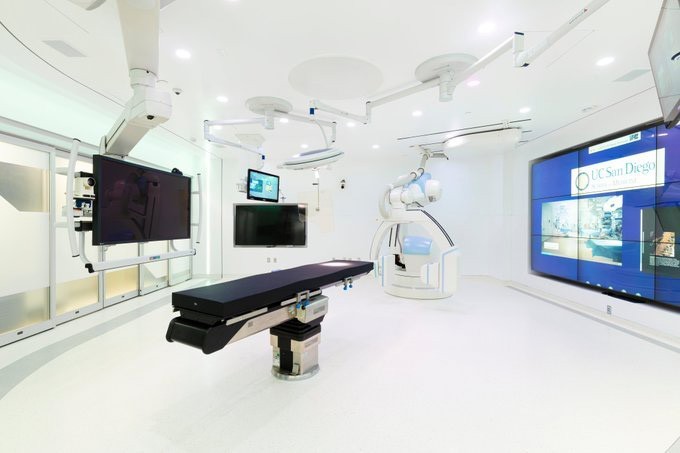The Center for the Future of Surgery (CFS) at University of California-San Diego School of Medicine is “dedicated to advancing surgical techniques” by “utilizing high-tech simulated operating rooms” that allow surgeons to “refine their skills, learn and develop cutting-edge techniques without any risk to their patients.” [related]
The center opened in 2011 and has since trained more than 25,000 surgeons, nurses, medical students and industry partners. Doctors at the center combine imaging and surgery real-time in the Hybrid Operating Room, which includes state-of-the-art AV and advanced medical equipment.
In fall of 2019, the center underwent a major expansion and incorporated technology to support the latest surgical trends with an emphasis on both brain and nervous system treatments.
As part of the expansion and upgrade, the Center for the Future of Surgery added two new training spaces to the 22,000-square-foot facility: a microsurgical suite, which enables surgeons to perform highly delicate procedures on brains and nerves, and a hybrid operating room which pairs medical imaging to The Wall of Knowledge.
The Wall of Knowledge is a nine-screen MultiTaction touch video wall featuring the company’s full suite of collaboration and visualization software.
The 3×3 MultiTaction unlimited touch, interactive video wall “ties together multiple video and computer sources and allows surgical teams to plan, review, and collaborate in real-time.”
“The result is a space where live real-time visual information can be captured and explored, analyzed and compared by a surgical team directly in the operating room,” according to the MultiTaction announcement. The setup allows for “better instruction and learning as well as for developing and refining new techniques.”
Beyond the Wall of Knowledge
CFS needed a solution that could be leveraged by multiple users simultaneously while performing separate tasks and also while collaborating in teams. The touch technology needed to be intuitive and highly responsive and the solution needed to capture video output from a myriad of medical devices and cameras.
They needed a system designed for a critical environment with constant heavy use by multiple teams of surgeons, researchers, and educators.
Incorporating a large touch video wall into an operating room comes with certain challenges. The Wall of Knowledge needed to be responsive to both gloved and ungloved hands, and it needs to have a touch system that allows for many people to be working simultaneously and quickly.
It needs to have a robust touch system that can stand up to hard everyday use and have the best possible uptime and connectivity.
Live video feeds will need to be captured and manipulated easily, and the software solution needs to allow cross-referencing archived data with live data, access to web content, remote controlling network connected computers, plus allow for seamless annotation while multiple users are operating the wall in different ways.
MultiTaction displays have integrated camera-based IR touch with 32 cameras embedded into each display panel, allowing for extremely responsive touch for all hands, gloved or otherwise. Panels are each independent of one another, so no amount of misalignment will lead to phantom-touches or reduced touch performance.
The company’s touch communication uses standard ethernet (not USB) ensuring maximum uptime in any environment and endless expandability, which is especially important in an operating room environment.
Why CFS Chose MultiTaction
Dr. Santiago Horgan is both the director of the center and the visionary driving new technology into the operating room. He first experienced MultiTaction’s touch technology during a visit to Stryker Corporation where several MultiTaction panels were installed in their California headquarters.
That visit made him think about how having an interactive wall in the hybrid operating room would add functionality for both the surgeons teaching courses and for those learning. The camera-based touch was a standout and set the stage for the Wall of Knowledge to be incorporated into the hybrid operating room.
San Diego-based Fluid Sound was UCSD’s choice for the AV upgrade and expansion. The result is what MultiTaction calls “a cohesive digital experience that ties medical and AV devices together into a complete solution that is as functional as it is high-tech.”
The hybrid operating room at The Center for the Future of Surgery is designed as a working operating room simulation where procedures can be practiced and developed without risk to a live patient.
“The Center offers surgeons of all specialties a rare opportunity to train on the newest techniques and technologies outside of a live operating room,” said Horgan. “This is where the next generation of surgeons is acquiring hands-on knowledge and experience to pro- vide patients with the best, safest operations possible.”
MultiTaction’s Canvus software provides the ability to combine live video feeds, archived videos, images, PDFs, websites and more and have all these assets available for multiple users to interact with concurrently. The system accepts live streaming feeds, RDP connections to remote machines and more. To further expand capabilities the center has the option to add a Canvus Connect server, which adds the ability to link sites or allow multiple remote users to connect to a collaboration session.
MultiTaction’s Showcase presentation software was also installed on the wall to address the center’s need to build interactive and engaging presentations for visitors and guests to the facility. Showcase allows CFS to produce, customize and update this content like this in-house quickly and easily to further enhance the visitor experience.
It took over six years in planning and a year of development for Horgan and his team to bring CFS 2.0 into existence. The CFS Hybrid Operating Room remains, in his words, “the most advanced in the country and worldwide.
Horgan has said that in the next 10 years he hopes to have CFS 3.0 the next iteration of the Center and the most advanced robotic surgery facility in the world.











